Garter snakes are among the most prevalent snakes in North America, and you may frequently find them in fields, gardens, and woodlands.
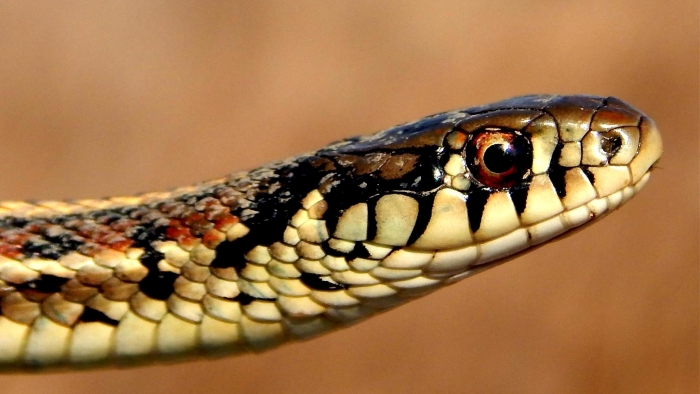
For the most part, they are safe among humans, but what about dogs? Can a garter snake hurt a dog if it bites or sprays its musk?
As we examine the realities and urban legends surrounding garter snakes and dogs in this blog, we’ll also offer some advice on how to avoid and handle future encounters.
Contents
What are Garter Snakes?
Garter snakes (genus Thamnophis) are a group of non–venomous, small to medium-sized snakes belonging to the family Colubridae.
They are commonly found in North America, ranging from Canada to Central America.
These snakes are known for their distinctive coloration, which often includes longitudinal stripes along their bodies[1].
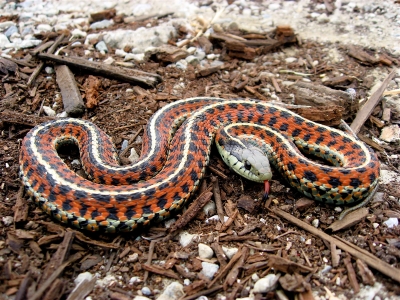
Some key characteristics of garter snakes include:
- Coloration
The background color of garter snakes may normally range from green to brown, and they have a pattern of transverse stripes that run the length of their bodies.
These stripes, which might be white, yellow, or orange, aid in identification and come in a variety of hues.
- Size
Depending on the species, garter snake adults generally measure between 18 and 55 inches (45 and 140 cm) in length.
- Diet
Garter snakes are omnivorous carnivores that mostly eat insects, worms, tiny amphibians, fish, and occasionally even small animals.
- Habitat
They are adaptable snakes that can be found in a wide range of habitats, including grasslands, woodlands, meadows, wetlands, and near water sources such as streams and ponds.
- Behavior
Garter snakes are known for releasing a musky odor when threatened or handled. This is a defense mechanism to deter predators.
They are also active during the day, making them diurnal.
- Reproduction
Garter snakes give birth to live young, a reproductive strategy known as Viviparity.
Females typically give birth to a small number of live snakelets after carrying the embryos internally.
- Ecological Importance
Garter snakes are important for maintaining the balance of the local ecosystems by regulating the numbers of their targets, such as insects and tiny animals like rodents.
Can Garter Snakes Hurt Dogs?
The dog’s interaction with the garter snake determines the correct answer to this question.
Garter snake bites are generally not dangerous and do not need medical care.
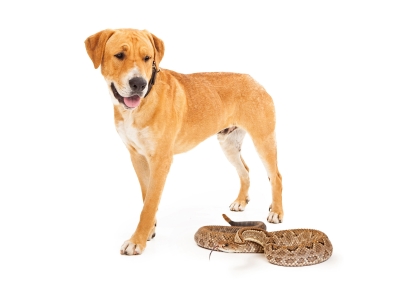
However, various circumstances can alter the intensity of the bite and the dog’s reaction.
- The size and health of the dog: Smaller or weaker canines may be more vulnerable to the venom’s or musk’s effects than larger or stronger dogs.
- The location and number of bites: Bites on the face, eyes, mouth, or nose may cause greater discomfort and irritation than bites to other regions of the body. Multiple bites can also raise the likelihood of illness or an allergic reaction.
- The ingestion of the snake: Some dogs may try to eat the garter snake after biting it or finding it dead. This can pose a serious health hazard, as the snake may contain parasites, bacteria, or toxins that can harm the dog’s digestive system or internal organs.
- The allergic reaction: Some dogs may have an allergic response to the venom or smell of the garter snake, resulting in symptoms such as rashes, itching, trouble breathing, shock, or even death. This is uncommon, but it is conceivable, and it needs emergency veterinarian intervention.
The Myth of Garter Snake Bites
Garter snakes do not have fangs or venom glands like some other snakes, but they do have rows of teeth and saliva that contains mild toxins[2].
These toxins are not enough to cause serious harm to dogs, but they can cause some irritation at the site of the bite.
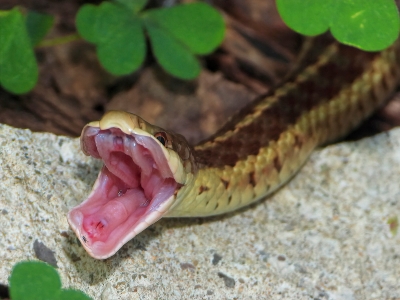
The American Kennel Club states that “Dogs may have acute swelling, discomfort, and bleeding from garter snake bites in addition to redness, bruising, and bleeding.“
The dog may lick or scratch the wound after the bite if it itches or burns.
The dog may find these symptoms uncomfortable, but they often go away in a few hours or days.
Garter Snake Musk
Garter snakes have another defense mechanism besides biting: they can release a pungent musk from their anal glands when they feel threatened.
This musk is not toxic, but it can cause gagging, salivating, vomiting, or swelling in dogs that come into contact with it
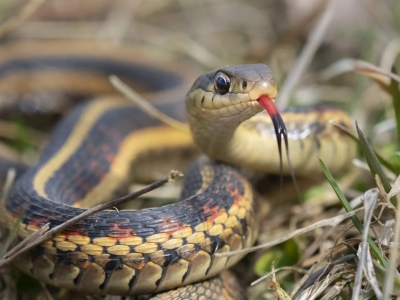
Additionally, the musk might adhere to the dog’s skin and fur, leaving them smelling bad for a very long time.
Washing the dog as soon as you can with mild soap and water can help get rid of the musk.
To prevent irritating the dog’s skin or eyes, stay away from harsh chemicals and products.
When to See a Vet
The majority of garter snake bites and musk sprays do not pose a life-threatening hazard to dogs, but they can still result in difficulties if not appropriately managed.
Some dogs could experience an allergic reaction to the snake’s scent or saliva, which might make them have trouble breathing and even shock or collapse.

Although unlikely, this is a possibility that needs prompt veterinarian care[3].
Another risk is infection, which can occur if the bite wound is not cleaned and disinfected promptly.
Signs of infection include pus, fever, lethargy, loss of appetite, or swelling that does not go down after a few days.
If you notice any of these signs, take your dog to the vet as soon as possible.
How to Prevent and Deal with Garter Snake Encounters
Keeping your dog away from garter snakes is the best way to prevent them from being sprayed with musk and getting bitten by one[4].
A garter snake encounter is less likely if you follow this advice:
- Keep your dog on a leash when walking in areas where garter snakes may live, such as fields, forests, or near water sources.
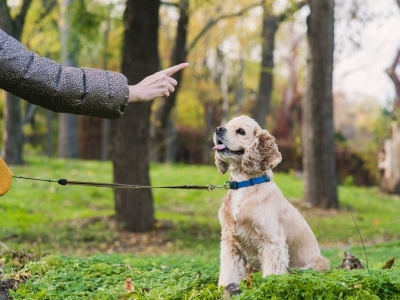
- Avoid letting your dog roam freely in your yard or garden if you know there are garter snakes around.
- You can also make your yard less attractive to garter snakes by removing piles of leaves, rocks, wood, or debris where they may hide.
- Teach your dog not to chase or play with snakes and to leave them alone.
- To teach your dog to avoid snakes or return to you when called, employ positive reinforcement and distraction strategies.
- Do not panic or attempt to kill a garter snake if you encounter one close to your dog.
- Replacing it with a calm walk away from the snake will allow your dog to escape.
- Most of the time, garter snakes are not aggressive; they only bite or spray when trapped or threatened.
- Replacing it with a calm walk away from the snake will allow your dog to escape.
FAQs
Are garter snakes venomous?
No, garter snakes are not venomous. They are non-venomous snakes that use defensive behaviors such as emitting a musky odor and releasing a mild secretion to deter predators.
Can garter snakes be harmful to other pets, like cats or birds?
Garter snakes typically use their defensive mechanisms to deter predators, so they are unlikely to cause harm to larger pets like cats. However, smaller pets like birds or rodents could be seen as potential prey.
What’s the best way to teach my dog to avoid snakes?
Training your dog to avoid snakes can be challenging. Professional dog trainers can offer guidance on creating a “snake aversion” training program that teaches dogs to associate the scent or sight of snakes with negative experiences.
Can I keep a garter snake as a pet if I have a dog?
While garter snakes can be kept as pets, it’s important to ensure that your dog and the snake are kept separate to prevent stress to both animals. Always research the care requirements of any pet you plan to bring into your home.
Are there other types of snakes that I should be more concerned about with my dog?
In certain regions, venomous snakes like rattlesnakes could pose a threat to dogs. It’s important to be aware of the snake species in your area and take appropriate precautions to keep your dog safe.
Conclusion
Garter snakes are generally not dangerous to dogs, but they can still cause some discomfort and inconvenience if they bite or spray their musk.
The best way to deal with garter snake encounters is to avoid them altogether by keeping your dog on a leash and away from snake habitats.
If your dog does get bitten or sprayed by a garter snake, monitor their symptoms and seek veterinary care if needed.
Reference:
- 20+ Types Of Garter Snakes: How to Identify These Garden Snakes | Everything Reptiles
- Anatomy of the mouth in the snake: Teeth and glottis | MediaSpace – the University of Nottingham.
- Snake Bite Safety and Prevention for your Pets | WebMD
- What to Do If a Snake Bites Your Dog | American Kennel Club

Dania is a dog groomer living in California, who loves styling dogs. She often uses dog accessories to keep them distracted while grooming. She is also a dog parent to a Pomeranian, Duke. It’s because of him she is always on a lookout for the best dog foods, toys, other dog accessories, and ways to keep him equipped, healthy and happy.


